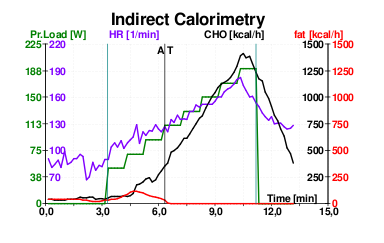Indirect calorimetry
Indirect calorimetry is a method used to estimate the oxygen consumption and carbon dioxide production rates of an organism, which are indicative of its metabolic rate. This technique is based on the principle that the amount of oxygen consumed and carbon dioxide produced can be used to calculate energy expenditure, assuming a steady state of gas exchange. Indirect calorimetry is widely used in various fields such as nutrition, exercise physiology, and critical care medicine to assess the metabolic status of individuals.
Principles[edit | edit source]
The fundamental principle behind indirect calorimetry is the measurement of oxygen consumption (VO2) and carbon dioxide production (VCO2). These measurements are used to calculate the respiratory quotient (RQ), which is the ratio of VCO2 to VO2. The RQ provides information about the substrate being metabolized for energy, with values typically ranging from 0.7 (indicating fat oxidation) to 1.0 (indicating carbohydrate oxidation).
Applications[edit | edit source]
Indirect calorimetry has a wide range of applications. In nutrition, it is used to assess the metabolic rate and thus tailor dietary interventions for weight management. In exercise physiology, it helps in evaluating an athlete's aerobic capacity and endurance. In critical care medicine, it is utilized to optimize nutritional support for critically ill patients, ensuring that their energy requirements are met without overfeeding or underfeeding.
Procedure[edit | edit source]
The procedure for conducting indirect calorimetry involves the use of a metabolic cart, which measures the volumes of oxygen consumed and carbon dioxide produced. The subject typically breathes into a mouthpiece or wears a mask connected to the metabolic cart, which captures and analyzes the exhaled gases. The data collected is then used to calculate the metabolic rate using standard equations.
Advantages and Limitations[edit | edit source]
One of the main advantages of indirect calorimetry is its non-invasive nature, making it a safe and relatively easy method to assess metabolic rate. However, the accuracy of the measurements can be affected by various factors, including the type of equipment used, the subject's compliance with the breathing apparatus, and the steady state of gas exchange.
Conclusion[edit | edit source]
Indirect calorimetry is a valuable tool in assessing the metabolic rate and understanding the energy expenditure of individuals. Its applications across various fields highlight its importance in both research and clinical settings. Despite its limitations, it remains a widely used method for evaluating metabolic health and guiding nutritional and exercise interventions.
Translate: - East Asian
中文,
日本,
한국어,
South Asian
हिन्दी,
தமிழ்,
తెలుగు,
Urdu,
ಕನ್ನಡ,
Southeast Asian
Indonesian,
Vietnamese,
Thai,
မြန်မာဘာသာ,
বাংলা
European
español,
Deutsch,
français,
Greek,
português do Brasil,
polski,
română,
русский,
Nederlands,
norsk,
svenska,
suomi,
Italian
Middle Eastern & African
عربى,
Turkish,
Persian,
Hebrew,
Afrikaans,
isiZulu,
Kiswahili,
Other
Bulgarian,
Hungarian,
Czech,
Swedish,
മലയാളം,
मराठी,
ਪੰਜਾਬੀ,
ગુજરાતી,
Portuguese,
Ukrainian
Navigation: Wellness - Encyclopedia - Health topics - Disease Index - Drugs - World Directory - Gray's Anatomy - Keto diet - Recipes
Search WikiMD
Ad.Tired of being Overweight? Try W8MD's physician weight loss program.
Semaglutide (Ozempic / Wegovy and Tirzepatide (Mounjaro) available.
Advertise on WikiMD
WikiMD is not a substitute for professional medical advice. See full disclaimer.
Credits:Most images are courtesy of Wikimedia commons, and templates Wikipedia, licensed under CC BY SA or similar.
Contributors: Prab R. Tumpati, MD

